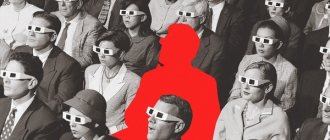Method of introspection
Introspection is reflection, that is, a person’s focus deep within himself, which differs from his focus on the outside world. The main method of introspection is self-observation. But there is a flaw here - no one can evaluate the correctness of a person’s work during introspection, because in essence a person is engaged in subjective observation. He evaluates himself in a way that suits him. Here you can resort to various forms of psychological defenses in order not to notice certain qualities in yourself.
Introspection methods are divided into types:
- Analytical - analysis of feelings and emotions into parts, details, examining them down to the smallest detail.
- Systematic – analysis of one’s feelings and thoughts after performing specific actions, that is, after the fact.
- Phenomenological – a description of one’s internal state without experiencing it traumatically.
To cope with any, even the most difficult situation, it is very important to understand your own feelings. When you realize that you are angry, bored, offended, etc.
etc., then it’s easy for you to determine the reason for this feeling, and then communicate with yourself about how objective these reasons are.
In fact, you may not be angry where you would normally be angry; do not be offended where you are usually offended; not to be afraid where you are used to being afraid, etc. But to do this, you must first trace these feelings in yourself, understand the reasons for their occurrence and realize how stupid, childish or unnecessary they are sometimes. You can work on not reacting negatively to certain events. Why be upset again? After all, life can be made a holiday if you understand that many troubles happen for harmless reasons.
Even if the reason for your grief is serious and objective, you also have the right not to be upset about it. Who told you that you should cry if someone dies? To whom do you owe grief if a loved one leaves you? Even if the reasons are serious, you can say to yourself: “Yes, the situation is unpleasant, I want to cry, take revenge, beat my offender. But I may not react to this situation at all. What happened happened. I just won’t think about it, but will continue to live my happy life.”
Let your life be independent of what other people do. Become the master of your own happiness, which depends only on what you do. Unpleasant situations may happen to you, but you have the right to choose what feelings and emotions to experience. After all, you can rejoice at the departure of your loved one (“Now I won’t have to do what only he (she) wanted, and be what he (she) wanted me to see”; you have gained freedom to express yourself) or be indifferent to the fact that you were not promoted (“And thank God. But I will be able to spend more time with the people I love”).
Find the positive in a situation that is usually perceived negatively. And remember that you are free to choose not only your feelings, but also the people with whom you will continue to communicate, the places you will visit in the future. You are not obligated to maintain relationships with those people who deprive you of happiness and joy. It is better to be alone than to communicate with those who parasitize on your desire to achieve success and perfection.
Edwin G. Boring. History of introspection Added by Psychology OnLine.Net 10/13/2008 (Edit 12/06/2009) The correct, but cumbersome title of this article would be: “The history of the use of consciousness as a means of observation in scientific psychology.” If conscious experience can be said to exist, then we are faced with the question: should modern psychology not take into account data about it, as it did before? My work could even be called: “What happened to introspection?” One of the common answers is this: introspection turned out to be unviable and therefore gradually began to lose its position. However, another answer is possible: introspection is still with us, it finds its use in a variety of ways, and verbal reporting is only one of them. The first statement - about the collapse of introspection - can be considered true if we are talking about the kind of introspection that Titchener developed at Cornell in 1900-1920, while the second - about disguised introspection - is accepted by modern researchers who claim that the concept of conscious experience makes sense only if it is defined at the operational level. Dualism
The belief in the existence of a conscious mind in man is as old as philosophy and belief in the immortality of the soul - this immortal part of man, which is not just a mortal body.
Hence it happened that something conscious is usually only one component in a dualistic contradiction, for example, spirit as opposed to matter, rational as opposed to irrational, goal as opposed to mechanism. There were also psychological monists, for example La Mettrie [44], a materialist who in 1748 argued that man is a machine (which brought upon himself the curse of theologians), but even he was much more successful in reducing the mental states isolated by dualism to their bodily basis, rather than in describing a person without resorting to dualism. The dogma of the immortality of the soul and the long dominance of theology inevitably influenced psychology. The terms for soul and psyche are not distinguished as clearly in French and German (Gate; Seele), nor in Greek and Latin (psyshe, nous; anima, mens) as they are in the English translation. It was the ability of thinking that claimed immortality, and Descartes, a zealous Catholic, endows man with a rational soul created from an unextended eternal substance, and comes to the conclusion that animals are dead, soulless automata [20]. Thus, Descartes became the founder of both the dualistic line (using introspection in relation to consciousness) and the objective approach (with a mechanistic understanding of the reflex). English empiricism consolidated dualism and established the concept of consciousness in psychology. Locke, Berkeley, Hume, Hartley, Reed, Stuart, Thomas Browne, both Mill and Bain all described in different ways how the mind comes to understand the external world. They recognized the basic spirit-matter dichotomy. It is now believed that these philosophers have the credit of discovering the association that defines the relationships between the elements that make up the mind or consciousness [8. R. 157-245]. There was no previously (and has not yet been found) a suitable term to designate the non-material part of the “spirit - matter” dichotomy. James complained about this in 1890 [32, I.R. 185-187]. Most often, either the term “soul” (mind; Seele) or consciousness (consciousness; BewuBtheit) is used. Psychologists of the 19th century referred to this dichotomy as psychophysical parallelism, and this dogma was so firmly imprinted in psychological thinking that the American “operational revolution” of the current century was able to win only after overcoming enormous difficulties. It is hardly worth going into much detail here, describing the history of belief in what we call consciousness. For many centuries, the existence of consciousness seemed to be an obvious, self-evident fact, a basic, undeniable reality of our own existence. “Cogito, ergo sum,” said Descartes. James summarized it this way [32, I. R. 185]: “Introspective observation is what we should rely on first, mainly and always. The concept of "introspection" needs to be clearly defined - it obviously means looking into our own soul and reporting what we discover there. Everyone will agree that we discover states of consciousness in this case. As far as I know, the existence of such states has never been questioned by any critic, no matter how skeptic he may be in other respects. The existence of knowledge of this kind is an unshakable fact, while in relation to other phenomena it often happens that in the sphere of philosophical doubt they suddenly lose the clarity of their outlines. All people are unshakably confident that they feel themselves thinking, that they can distinguish their mental states (such as internal activity or passion) from the objects that cause these states. I consider this certainty to be the most fundamental postulate of psychology, and I reject any investigation of this certainty as too metaphysical.” In general, philosophers, physiologists and physicists who laid the foundations of the new experimental psychology in 1850-1870. Fechner, Lotze, Helmholtz, Wundt, Goering, Mach and their associates were supporters of the concept of psychophysical parallelism, who would fully agree with James’s point of view. Psychology (even the new “physiological psychology”) was essentially the study of consciousness, and its main method was introspection. Physiology merged with psychology because the “parallelists” believed the position expressed by Huxley: “there is no psyche without a nervous one” [30], and therefore used the equipment of a physiological laboratory to control stimulation and record the effects of nervous responses. So what is introspection (innere Wahrnehmung)? There are many opinions regarding how consciousness observes its own processes, their history dates back to Aristotle and Plato. Eisler summarized the views of 84 authors on this topic from Aristotle to the beginning of this century [21, III. R. 1735-1742]. Locke, the founder of empiricism, argued that all ideas - we should say: "contents of consciousness" - arise either through sensory experience, which provides knowledge of the external world, or through reflection - the internal sense, which provides knowledge of the soul's own actions. Early empiricists believed that neither sensation nor reflection could mislead a person. The belief has developed that to have a conscious experience is the same as to know that you have it. This allowed Wundt, who built his new systematic physiological psychology on the basis of English sensationalism, to decisively define introspection as direct experience [98. R. 1-6]. He believed that the facts of physical science are mediated and derived through inferences from the conclusions of direct experience, in which and through which they are directly given and constitute the subjective subject of psychology. This point of view suggests that, according to Wundt, introspection cannot “deceive,” but in fact we see a contradiction here, since Wundt’s laboratory placed great emphasis on training the ability to introspectively observe and accurately describe consciousness. Brentano wrote in 1874: “Phenomena comprehensible mentally are true in themselves. Since they arise, they exist in reality. Who will refuse to recognize in this the enormous advantage of psychology over the physical sciences? [12, 1. R. 131 - 203]. James remarked to this: “If it were quite enough to have feelings or thoughts in their immediate reality, then the child in the cradle would be a psychologist and, moreover, infallible!” [32, 1. R. 189]. Auguste Comte, the founder of positivism, gave the classic objection to the apparent adequacy of direct experience by pointing out that introspection, being an activity of the soul, will always find the soul engaged in introspection, but never in any other of the various activities. In essence, Comte's argument is much more than just a play on words. It corresponds to the statement that introspection is not a procedure, but only a recognition of the fact that knowledge, once given, exists as knowledge. Comte complained, like a nineteenth-century behaviorist, that introspection is unreliable, that it produces descriptions that often cannot be verified, that in many respects its data lack the positive character required by science. D. S. Mill responded to Comte's objections and argued that introspection is a process that requires training to ensure reliability. It is not strictly immediate, since it includes memory - perhaps immediate memory, however, immediate memories are not data in themselves, and here the possibility of error arises [53. R, 64]. Regarding this issue in general, see the brilliant arguments of James [32, 1. R. 187-192]. Mill's point is supported by the modern understanding that it is almost impossible to distinguish anesthesia from immediate anterograde amnesia: a person whose memory lasts 1 second has an equally profoundly defective capacity for introspection, since he is practically as unconscious as any reacting organism or machine. Classical Introspection
It can be considered classical introspection, which was defined through fairly formal rules and principles and arose directly from the early studies of Wundt's laboratory in Leipzig.
Of course, there are no fixed rules for introspection. Great people tend to disagree with each other and change their positions. Nevertheless, in essence, both Wundt and Külpe before his departure from Leipzig, and G. E. Müller in Göttingen, and Titchener at Cornell, and many other less important “introspectionists” who recognized the primacy of these scientists were united. Stumpf in Berlin adhered to less strict principles, and the later introspectionist doctrine of Külpe, developed by him after he came to Würzburg, is opposed to Wundt and Titchener. Classical introspection in a general sense is the belief that the description of consciousness reveals complexes formed by a system of sensory elements. It was against this doctrine that Külpe rebelled in Würzburg, the behaviorists under the leadership of Watson, and the Gestalt psychologists at the initiative of Wertheimer. Introspectionism received its “-ism” because the rising new schools needed a clear and precise designation of the grounds to which they contrasted their own, fundamentally new features. No proponent of introspection as a basic method of psychology has ever called himself an introspectionist. He usually called himself a psychologist. Wundt, who tried to establish the new psychology as a science, turned to chemistry as its model. The consequence of this choice was the elementalism of his system, supplemented by associationism in order to ensure the tasks of synthesis. Psychological atoms are sensations (pure sensations) and perhaps also simple feelings and images. Psychological molecules are representations (Vorstellngen) and more complex formations (Verbindungen). As Wundt's views regarding simple feelings and images changed over time, it was sensations that became the constant "stuff" of all good descriptions of consciousness. Thus, half a century later, Titchener concludes that “sensory” is an adjective that best designates the nature of the contents of consciousness [85. R. 259-268]. With his understanding of introspection, Wundt fixed elementalism and sensationalism, and subsequently introspectionism in its laboratories invariably discovered sensory elements, since they were the results of “good” observation. It is reasonable to assume that the very atmosphere of the laboratory and the local cultural tradition did more to perpetuate these ideas than the arguments given in defense of the observation in publications. Although Wundt defined direct experience as the subject of psychology [97; 98. R. 1-6], he nevertheless distinguished between introspection (Selbstbeobachtung) and internal perception (innere Wahrnehmung). Inner perception may be valuable in itself, but it is not science. Wundt insisted on training his subjects. Even in the reaction time experiments in the Leipzig laboratory, subjects had to train for a long time to perform prescribed acts of perception, apperception, recognition, discrimination, judgment, choice, etc., and also immediately report when consciousness deviates from the required tasks. Thus, Wundt pointed out that no subject who performed less than 10,000 introspectively controlled reactions was suitable as a source of information for publication from his laboratory. Some Americans, Cattell among them, believed, however, that the psyche of an untrained subject could also be of interest to psychology, and later a small discussion arose on this issue between Baldwin and Titchener [8. R. 413, 556]. In general, Wundt's understanding of introspection was much more liberal than is usually thought: in formal introspection he left room for both retrospection and indirect reporting. He was much less malleable in relation to the elements and their sensory nature. An event for introspection was the acceptance of the concept according to which physics and psychology differ from each other not in fundamental material, but only in points of view on it. Mach in 1886 put forward the position that experience (“sensation”) is the subject of all sciences [48], and Avenarius a few years later - that psychology considers experience dependent on the functioning of the nervous system (he called it “system C”) , and physics - as independent of it [3]. Then, when these two philosophers agreed that there was no contradiction between them, they had a great influence on Külpe and Titchener, who were then in Leipzig. Külpe, in his 1893 textbook, presented this difference between psychology and the natural sciences as a difference in points of view [41. R. 9-13], but Titchener attached especially great importance to it. In 1910, he said that the data of introspection are “the total sum of human experience, considered depending on the experiencing subject” [79. R. 1-25], and later he was able to write the formula: introspection = psychological (clear experience -> report), which means: introspection is the presence of a clear experience from a psychological point of view and a report about it, also from a psychological point of view [ 83. R. 1-26]. Replace the psychological with the physical and you get a formula for physics. A well-worn example of introspection is illusion: the case where a perception differs in some respect from the stimulus-object. In perception, experience is considered exactly as it occurs, depending on the nature of perception by the perceiving person, that is, depending on the activity of his nervous system. The subject must distract from the physical texture of the object. Let the physicist address it using measurements and other physical techniques. Titchener defended this view of this distinction throughout his life [85. R. 259-268]. It was Külpe who split Wundt’s psychological atom, decomposing sensation into four indivisible but independently changing properties: quality, intensity, extension and duration [41. R. 30-38]. This view was later shared by Titchener [6. R. 17-35]. One of the most comprehensive discussions on the problems of introspection was started by the polymath Müller in 1911 [55. R. 61 - 176]. He turned out to be even more liberal than Wundt, and left room for all indirect and retrospective forms of introspection. Being primarily interested in the application of introspection to the study of memory, he distinguished between the present memory of a past apperception of a past event and the present apperception of a present memory of a past event, an important distinction since the current apperception can be questioned, but the past apperception is fixed and can no longer serve as a subject of study . It was Titchener who placed the greatest limitation on introspection by demanding that meaning be excluded from all descriptions of consciousness. At first, Titchener kept this idea to himself, calling the values that appeared in the reports stimulus errors. He insisted that a trained subject who has adopted a psychological point of view describes consciousness (dependent experience) and makes no attempt to describe the stimulus-object (independent experience given from the point of view of physics) [5; 79. R. 22]. After Külpe tried to detect imageless (non-sensory) thoughts in the conscious processes of judgment, action and other thought processes, Titchener based his criticism of these positions on the prohibition of using any meanings in the data of introspection [80]. He argued that direct description {Beschreibung, cognitio rei) would yield the kind of sensory contents that became standard in classical introspection, and that inferences about the data of consciousness {Kundgabe, cognitio circa rem) are meanings that do not exist as observable sensory processes [ 81; 82]. Hence his psychology even received the name existential, because he was convinced that meanings that act as assumptions are devoid of the positive character that sensations and images have as existential data. It has never been entirely true that introspection is a photograph and that it has been developed without the aid of assumptions and meanings. Let us turn to Titchener’s typical introspective studies [16; 25; 28; 31; 58; 59; 64]. There is too much dependence on retrospection. Sometimes it took 20 minutes to describe a state of consciousness that lasted 1.5 seconds, and during this time the subject racked his brains, trying to remember what actually happened more than 1000 seconds before, relying, of course, on assumptions. At the Yale APA meeting in 1913, J. W. Baird enthusiastically prepared a public demonstration of introspection by a trained subject, but the performance was not impressive. Introspection, with a reduced number of sentences and meanings, resulted in a boring enumeration of sensory elements that were considered to have almost no functional value for the body and therefore were of no interest, especially to American scientists. The classic introducing, it seems to me, lost its brilliance after the death of Titchener in 1927, since it demonstrated functional uselessness, seemed boring and was also inaccurate. The very spirit of laboratory studies is inherent in a descriptive approach, so what is obtained in one laboratory cannot be verified in another: it is impossible to verify the truth of introducing reports on the states of consciousness that accompany the action, feeling, choice and judgment. Therefore, it does not have to be surprised that Kyulpe, Watson and Vertheimer, all for one decade (1904-1913), vigorously opposed the shackles of this idealistic, but hard pedantry. The description of the impassable
, which was called the systematic experimental introduction, developed in Würzburg in 1901 - 1905.
Under the leadership of Külpe [8. R. 101 - 410, 433–435]. Kyulpe, who, who, experimental psychology, experimental psychology should also study thinking from Leipzig to Würzburg, with the conviction that experimental psychology should also study. The new experimental psychology knew how to handle sensation, perception and reaction, and Ebbinghaus in 1885 added memory to this list. Wundt said that thought cannot be studied experimentally. However, positivist Külpe was sure that he only needed to find subjects, ready to think in controlled conditions, and then get an introspective report on mental processes from them. The brilliant series of works performed by the students of Kyulpe: Mayer and Orthi on Association (1901), Marbe, in judgment, Orthi in feeling (1903), Watt in thinking (1905), akho in action and thinking (1905). In each of these works, it was stated that the so -called classic introducing does not correspond to any of these problems. Mayer and ORT described the chain of associated images in the process of thinking, but did not find any indications of how the thought is sent to their goal in the introduction [50]. Marbe found that if judgments can be easily expressed in terms of images, then the introduction does not give the slightest hint of how and why they are formed [49]. In Orth’s research, the feeling “resisted” the introspective analysis, so he had to invent a not quite clear term conscious attitude to describe the emotional (affective) life. In his subjects, of course, feelings did not appear in the form of sensations or images. Watt and Ah, independently of each other, came to mutually consistent results. Watt, in order to make an introduction more efficiently, invented a fragmentation technique: he divided the psychological event (Event) into several of the other periods and investigated each of them separately, thereby achieving reduction of memory and conclusions (Inference), which were included in Introspective report. Nevertheless, the essence of thinking remained elusive for him, until he finally understood that the purposefulness of thinking was set by the task or instruction (he called this the task - Aufgabe), which the subject accepted before the process of his thinking began [92]. Ah developed the concept of a determinating trend as a leading unconscious principle, which directs conscious processes according to a predetermined direction in the direction of solving the problem. He also developed a cronoscopic control procedure with chronoscopic control and gave the formulation of the method - a systematic experimental introduction. And the determinative trend, which in itself is unconscious, and the conscious processes directed by it, were unusual for the subjects in terms of the classical introduction, that is, in the language of sensations and images. For these vague, elusive content of consciousness, Ahu had to introduce the term consciousness, and his subjects learned to describe their consciousness in terms of the beloved residence of consciousness (Unanschauliche Bewbtheiten - German) [1]. Representatives of the Würzburg school believed that with the help of the Introspectus method, they discovered a new type of mental elements, but the concept of consciousness did not receive the status of the sensation and image. Instead, they talked about the opening of the Würzburg school of ugly thinking, and many people reproach her: the discovery is purely negative, even though thoughts are not images, but what are they? Titchener, however, believed that he knew the answer to this question. According to Titcheener, the thoughts that the Wurzburgians are talking about are partly conscious relations (attitudes), which are vague, fleeting patterns of sensations and images, partly the meanings and judgments that should be excluded from psychology, because the task of studying is not an adequate description [80]. From the height of the past 40 years, we see that the main contribution of this school is an understanding of the importance of an unconscious task and determining trend. The course of thought is determined unconsciously - this is the conclusion that was prepared by the spirit of the times during its opening: then Freud discovered that the area of motivation is usually unavailable. However, the conclusion of Kyulpe was somewhat different from such an understanding. He believed that the presence of barely perceptible consciousnesses in the minds were established reliably, but at the same time called them functions in order to distinguish from the sensations and images of the classical investment, which he called the contents [43]. The function and content are two types of data about the consciousness that constitute together what is designated as a two -part psychology of the late Külpe. So, his choice, Külpe, united the Wundt Introspect with the Brentano Introspect. He also contributed to the upcoming protest against the Wundt introspection by gestaltpsichology. The awareness of mental activity
at that time almost all philosophers and psychologists were dualists, and most psychologists are also psychophysical parallelists.
If you believe that the phenomena of consciousness depend on the processes in the brain, but are completely separated and excellent from them, then you must also allow some kind of introduction or internal perception, through which you receive certificates of mental phenomena. Biheviorist monism of the XX century. was unknown in the XIX century. Belief in a certain kind of investment was common for both psychology and for everyday consciousness. The appeal to the introspection was especially important for the psychology of the act, which stated that a thorough and impartial study of consciousness shows that it consists not of stable elements similar to images and sensations, but of intentional acts sent to objects, or acts consciously fixed to the goal [8. P, 439-456, 715–721]. We have already seen that Brentano defended the introduct of the introductory as self-unavated. He was a representative of the intentional psychology of the act and, being a contemporary of Wundt, formulated a dilemma between Wundor elements of consciousness and his acts [12]. Brentano influenced the subject-object-contextual psychology (volitional action) of James Ward 1886, revised by him in 1918 [87], and Ward influenced MacDulla, which, despite the fact that they have already defined psychology as the science of about behavior, developed in 1923 targeted psychology - such a system in which the goal and desire was a characteristic of any mental activity [51]. In Germany, Stumpf, stimulated by Brentano's teaching about mental acts and the arguments of Husserl in favor of phenomenology as the most important description of experience [29], came to the conclusion that the Wundt introduction produces phenomenology, however, psychology most likely consists of acts (Brentano), or, as Stumf called them mental functions [76]. Thus, it will be correct to say that by 1915 both Stumpf and Kyulpe believed that there are two kinds of introspective data: on the one hand, phenomena (StumPF) and elements (kyulpe), on the other hand, both believed in functions (acts). Kyulpe was inclined to think that the functions were observed retrospectively (Ruckschaunde Selbstbeobachtung), and the elements immediately (Anschaunde Selbstbeobachtung) [43. P 42-45]. With the exception of Titchener and his associates, American psychology all the time sought to be practical and functional in the Darwin sense. As such, she was predetermined to become behaviorist. Therefore, it is interesting to note that the early American functional psychology of James, Dewe, Angella and the Chicago school was introspective. Organisms have acquired consciousness due to its adaptive function, their argument read. “When the even course of the usual action is interrupted by external events, then in order to solve the problems of the body,” said Jailie Angell, “consciousness turns on,” [29. R. 276-278]. It is precisely due to the fact that the functional psychology considered the data of consciousness as something essential for understanding the adaptation of a person to his environment, Watson, laying the foundations of behaviorism, proclaimed that he was as much against functional psychology as against introspects. The phenomenological description
The following protest against the foundations of the classical introduction is associated with the discoveries of gestaltpsichology, generally speaking, with the discoveries of Vertheimer, set out in his work in 1912 for the perception of movement [94]. Vertheimer investigated the conditions for the emergence of the visible movement. It turns out that the movement can also be observed when the stimulus object does not move, as in the case of a discrete stimulus, that is, the visible movement is a phenomenon of consciousness, and not a physical phenomenon. The classical introduction would require to describe the perceived movement in terms or elements of consciousness, or mental processes, or images and sensations, or, possibly, the qualities of sensations. However, Vertheimer thought that any appeal in the analysis of these concepts would be unnecessary. The perceived movement can be recognized by itself, the conditions that caused it can be studied - why then to mess with these Leipzig apparents of the explanation? Since the visible movement, thus, can be immediately accepted as the identified phenomenon, Vertheimer called him a “fi-phenomenon”. In 1912, the idea of phenomenology was in the air. Husserl used this term to denote a free impartial description of experience (“being”) [29] - Stumpf adopted it [76]. Thus, Köhler and other psychologists began to talk about direct experience always as phenomena, avoiding all those words that were associated with the classical introduction. Later, it was such phenomenological observation that became the technique that changed the introduction [8. R; 601-607]. This Magna Carta phenomenology soon caused a lot of good studies to life for the most part on the problems of perception. The work of the Katz on the constraint of the brightness [34], performed in the laboratory of G. E. Müller, even several preceded the work of Wertheimer, and the classic study of the figure and background of Rubin [68] appeared only a little later, a whole series of searches for the laws of perception of form - research, and in which introduced new descriptive concepts, once: organization and articulation, and new functional concepts, such as proximity, isolation, transfer and constraint [8. R. 611-614]. Almost all these studies of perception were carried out in the spirit of dualism. This was expressed in attempts to find stimulus conditions or the structures of the brain, necessary and sufficient for the implementation of the perception process. Vertheimer, Köhler and Koffka - all of them supported the principle of isomorphism, that is, the hypothesis that the structure of the perception field is topologically similar to the structure of the field of the corresponding brain processes, and although neither gestaltpsichology, nor experimental phenomenology put forward isomorphism as a basic concept, topics No less isomorphism requires a certain dualism. And thus, both phenomena of perception and physiological processes of the brain are united by this term in psychophysiological accordance to each other. The beautiful book of Köhler 1920. Physical Gestalt defended this particular point of view [36]. At the same time, as Gestaltpsychology gained strength, the classical introduct of introducing was weakened. The work of Vertheimer on the phenomenal movement appeared in 1912 [94]. Kyulpea died in 1915. Köhler worked with monkeys on the island of Tenerif during the First World War, then he applied new phenomenological principles to the description of the psychology of monkeys [35]. Koffki students were occupied by publications of articles on perception problems. In 1920, Wundt died, that is, the year when Köhler published “Physical Gestalt” [36]. In 1922, Köhler arrived in Berlin to change Stumpf. In 1921, gestaltpsichologists began publishing a new Psychologische Forshung magazine, which reflects their interests, Vertheimer used the pages of his early issues for performances against the classical introduction [94]. Koffka outlined their essence in English for Americans in 1922 [38]. In 1927, Titchener died. Köhler's “Gestaltpsichology” appeared in 1929 [37], and the “principles” of Koffki in 1935 [39]. We can say that by 1930 phenomenological observation won over the classical introspection. Hitler was the reason that gestaltpsichologists who were able to work fruitfully moved to America. The victory of the phenomenology, which was facilitated by the death of Titcheener, was not triumphant, since other forces pushed American psychology to behaviorism. Nevertheless, phenomenology remained not only respected, but also turned out to be useful in the development of many psychological problems, as evidenced by a recent phenomenological study of the visible world, performed by Gibson [26]. So, here we have come to what we can say: the introspection is still practicing if the term introspection of its Cornello-Lipzig significance does not limit the term.
| Description | A correct but cumbersome title for this article would be: “The History of the Use of Consciousness as a Tool for Observation in Scientific Psychology.” If conscious experience can be said to exist, then we are faced with the question: should modern psychology not take into account data about it, as it did before? My work could even be called: “What happened to introspection?” One of the common answers is this: introspection turned out to be unviable and therefore gradually began to lose its position. However, another answer is possible: introspection is still with us, it finds its use in a variety of ways, and verbal reporting is only one of them. |
| Rating |
0/5 based on 0 votes. Median rating 0. |
| Tags | boring, introspection, soznanie, consciousness, introspection |
| Views | . On average per day. |
| Related articles | |
| Similar articles | Edwin Boring (1886—1968) History of behaviorism History of fortune telling by hand. K.J. Gergen. Social psychology as history History of psychology. Minimum program for the candidate exam |
What is introspection?
Introspection is a way of turning a person deep into himself for the purpose of self-knowledge. This is introspection, self-knowledge, introspection with the goal not to judge or evaluate, but with the goal of understanding oneself. This is how introspection differs from remorse, when a person begins to delve into himself, and then negatively evaluate his motives and actions, considering them wrong.
Introspection is a way to know yourself. To do this, a person must simply observe his mental processes, the emergence of desires, emotions, etc. There is no need to evaluate or condemn anything here. You just need to watch. If you do everything correctly, then you can not only understand yourself, but also realize why you made so many mistakes, what controls you. When a person understands himself, he can change in the direction in which he himself wishes.
In order to accept yourself as you are, you need to start with forgiveness. All people make mistakes. Sometimes a person blames himself more than other people do. Sometimes only you consider yourself to blame for something, and other people do not hold a grudge against you at all. Therefore, you need to forgive yourself first to see whether other people blame you or not.
When apologizing to someone, people sometimes do not forgive themselves. How can you be forgiven if you blame yourself for everything? Other people may have forgiven you a long time ago, but you continue to think that they are offended by you. Do you know why this happens? Because you blame yourself and from this you transfer your thoughts to other people. Everyone has already forgiven you, but it seems to you that they are offended at you because you do not forgive yourself. This is called "transference" when you project your own thoughts onto other people, thinking that they think about you in the same way as you think about yourself.
Forgive yourself first. Sometimes you don't need to ask other people for forgiveness. Sometimes you don’t need to waste your time and nerves seeking forgiveness from others. The most important thing is not to blame yourself. As long as you blame yourself and don’t forgive, even other people’s apologies won’t help you. But if you forgive yourself, then you may not even need the words “I forgive” from others.
The most important thing is to forgive yourself. Then it becomes clear whether you need to spend time seeking forgiveness from other people or whether they have already forgiven you a long time ago.
During the introspection process, it is important not to overdo it. After all, a person can go to the other extreme - self-examination
You need to not evaluate yourself, condemn or praise yourself, but simply get to know yourself, as if observing from the outside. If you begin to engage in self-examination, you will be guided by the desire to find some kind of flaw in yourself and reproach yourself for its presence.
Modern psychology, introspection and reflection
In current conditions, introspection is perceived as a historical stage in the development of psychological experiments. Now psychologists conduct research exactly the opposite. By analogy with the classic example of early psychology, in which introspection occupied a dominant place, the same object is taken - a red apple. But the subject must say what exactly he is holding in his hand, without going into analytical detail. This is the only way to analyze the psychological state of a person at the time of the experiment. Analytical introspection and introspection today are different concepts. Comprehension of the facts of one’s own consciousness is called monospection, and reflection is replaced by direct knowledge.
An experimental psychologist, when conducting a test task, relies on his own sophistication of the mind, and not on the intricate conclusions of the subject. Only in this respect the method of introspection is used as a tool of one’s own knowledge, and the data of introspection represent nothing more than professional experience.
Regarding the theory of dual consciousness, psychiatrists have a slightly different opinion, which is expressed in a clear formulation - schizophrenia. As for self-knowledge, it has nothing to do with introspection.
The place of method in philosophy
In philosophy, introspection is the basis of the psychological methodology of the retrospective direction of this science. The essence of Augustine's method of introspection is to free the mind and systematize a person's feelings, which his students agreed with. Preoccupation with one's own emotions can interfere with normal interpersonal relationships.
Introspection translated means “self-observation,” which in philosophy helps a person to calm the storm of feelings within himself. Introspection as a research method in psychology underlies a person’s knowledge of his own personal characteristics.
Description of the method
Introspection is very useful in a person’s knowledge of himself and his activities. This method is practical and does not require additional standards or tools. Its most significant advantage over other methods is that no one in any way can get to know a person better than he knows himself.
The method is very good because a person only needs his own help and desire. He must want to know himself and devote time to this.
But the method also has disadvantages, the most serious of which are:
- Bias - a person can exaggerate, embellish or not notice some features, distorting the picture of what he sees in himself.
- Subjectivity - a person perceives his inner world as he really wants to see it, that is, he can hide some aspects.
Adults, as Locke believed, perform the following basic actions:
- Knowledge of the surrounding reality.
- Processing information received from this reality.
Children are generally not able to carry out introspection, since their psyche is not sufficiently formed.
The problem of self-observation
In the course of numerous tests, it turned out that the self-observation method does not meet such criteria as repeatability and the ability to accurately record results. This was due to the fact that the participants were ordinary people who were distracted during the experiment and did not always provide accurate and timely feedback to the experimenter.
Thus, introspection turned out to be a method of studying not the mental processes themselves, but the traces that these processes leave in the human mind.
Another problem with using this method is its limitations: the results of self-observation establish the presence of a sign, but do not explain it. It can only be used to study perception, associations and feelings.
Method of introspection
According to his own teaching, which states that the human mind is capable of internal contemplation and analysis, J. Locke makes two fundamental statements:
- The activity of the human mind can occur on two levels, that is, “bifurcate”;
- The second level of consciousness requires training and attention, while the first is just a reflection of external factors.
Based on the possibility of doubling mental processes, the method of introspection has emerged, which presupposes the need to study and comprehend internal experience. The psychology of consciousness has adopted the following conclusions of the founder of the doctrine of introspection, J. Locke:
- To find out what is going on in a person’s soul, a psychologist is obliged to conduct research on himself. Only analogies drawn by the method of introspection will help to understand what exactly is happening to the subject. In a word, the psychologist must put himself in the place of his patient;
- Since not all people are prone to reflection, the feeling of introspection requires constant training, long-term and continuous exercise.
Psychology of the century before last accepted the method of introspection as the only correct one, since it reflected the causal relationship of all manifestations of the psyche. The specialist perceived external stimuli only from the point of view of the subject, that is, introspection assumed psychological facts without distortion by his own consciousness. At the end of the nineteenth century, psychologists around the world conducted a grand experiment to test the power of introspection under rigorous laboratory-like conditions.
As a result, big questions have arisen that touch on the colossal problems of the crisis in psychology. According to the instructions, the subjects avoided specific answers, but used terminological formulas. For example, a person could not say that he saw a red apple, but had to formulate a response at the request of introspection, that is, explain his feelings based on the color scheme and the expected taste sensation. Each subject spoke differently, as a result of which doubts arose among psychologists. How can psychology be successful if its introspection does not have uniform sensations? One sees the color red, the other thinks about the taste of an apple. The contradictions overturned the entire basis of practical psychology. In practice, it turned out that the specialist was not able to think in the categories of the subject.
Introspection in psychology
Introspection is popular in psychological practice, but many problems arise here, which are largely related to a person’s subjective vision of himself, as well as his reluctance to tell the whole truth about himself to others. The specialist can use introspection, but it will always be incomplete.
And yet introspection can be used independently, if only for the sake of simply knowing yourself. The most important criterion here remains observation. Do not try to evaluate and divide your manifestations into “bad” and “good”. Just watch and understand that you have it, don't run from it. If you want to use the knowledge gained in the process of introspection to change yourself, then it will be easy for you to do this.
From childhood onwards, all people first have their parents, then their educators and teachers, then their friends, other people and society as a whole say something, teach something and indicate something. If in childhood a child still takes everything on faith, then as he grows up, each person understands that society, parents and friends can also make mistakes. Moreover, there are people who use, manipulate, and provoke with the help of information.
Thus, the attitudes of society and parents are a way for a person to act to please them, perhaps to the detriment of himself.
How many people sacrifice themselves just because they were once told that they need to help their neighbors? How many people are willing to starve themselves just to feed their neighbors? How many people spend years getting a higher education instead of working and studying locally? How many people start families when they don't really want to? There are a great many such examples. And we can say that people suffer not because life is hard and unfair, but because people try to live by other people's rules, and not by their own.
It is better to listen to yourself when it comes to what kind of person you should be, what to strive for, how to live, who to love, where to work, etc. Everything that concerns you personally should remain the territory in which no one else has the right to command. In relationships with other people on shared territory, both partners are in command. But in your soul, head, thoughts, only you are the king.
If as a child you did not understand what was happening, now, as an adult, you have a choice. If you listen to someone, then it is your choice. And don’t cry because your life is bad. If you obey yourself, then you must understand that all results are your merit. Whatever one may say, you still answer. So, who are you going to listen to if the responsibility still remains with you?
Functions and role
Each person experiences different feelings during his life:
Discontent
Joy
Astonishment
Disturbance
Hatred
Love
Psychologists are interested in what it is and what a person experiences when they experience it. This is an attempt to explore consciousness as a physical object.
An important function of self-knowledge is studying oneself as an individual and knowing one’s goals in life. Introspection in psychology is the study of the content of oneself (narrow meaning) and understanding of what a person wants to achieve in the future, what he is striving for (broad meaning).
Using this method in a narrow sense allows you to find out your character traits, feelings that are important at the moment, intellectual abilities, thinking characteristics (attention, memory, concentration), etc.
This is important for understanding many things, for example, for choosing a future profession. When choosing a specific profession, it is important to know how well a person has developed the personal qualities to master it. Assessing your own abilities in your chosen field will help you adjust the level of certain qualities necessary to become a professional.
Throughout life, a person has to communicate with different categories of people. His position in society largely depends on this. Therefore, the role of self-knowledge is especially important for the development of communication skills and the ability to resolve complex conflict situations. This is also important when choosing a life partner and professional partner.
In the process of self-knowledge, it is important to set specific goals for yourself and follow the principle “I want - I can - I must.” Answering the questions: “What do I want?”, “What are my capabilities?” and “What do I need to achieve what I want?”, a person expands the boundaries of self-knowledge.
Psychologists note that the goals of self-analysis can be real and unrealistic. In the first case, a person analyzes what really exists (qualities inherent in nature), in the second, he tries to grasp what does not exist.
If it turns out that a person does not possess this quality or it is not sufficiently developed, self-knowledge can serve as a step towards further work on oneself.
Have you ever had a situation when, for example, a perfumer came to your home? He strikes up a conversation with you, talks about the product he brought, and lets you listen to different aromas. Ten minutes later, you walk into your apartment and buy groceries that you don't really need.
Without even noticing it, it happens. And such instant purchases are common. Decisions made spontaneously can lead to at least regrets, and sometimes to big problems. We are constantly influenced by the people around us. And it's not just about salespeople or intrusive advertising. We become infected with negative emotions from colleagues, get upset while standing in a traffic jam or in line at the bank, and fall under the influence of the group’s opinions.
We can easily succumb to general panic. How it works? In a situation of fear and uncertainty, in conditions of limited time, we cannot, or rather do not have time to decide where to move, although adrenaline requires us to react (to hit or run away). And then one person runs. Since we are social creatures, the instinct of self-preservation tells us to follow the leader. And all the people are running after this man.
But the problem is that this person may not have the slightest idea where he is running; he gave in to fear. But in a critical situation, we do not have time to analyze all this, and we just mindlessly follow it.
But if we have developed the skill of introspection, then in a difficult situation we can analyze it. What am I doing? What do I want? Why am I listening to a salesman who talks about the uniqueness of this men's perfume? Out of politeness? I don't want to be rude? But why do I need men's perfume if I live alone?
Or in a relationship with a toxic person. What does this person want from me? What feelings accompany me when I am next to him? Why do I need it? What do I really want? Why not leave? I can not? Should I stay with such a person? Who made me do this?
The same thing happens in a panic situation. They all ran. Where did they go? Who were they running after? They simply succumbed to the herd instinct. What I feel? Fear? Anxiety? What do I want? What would be good for me? Should I follow the crowd? Or do I need to go in a completely different direction?
All these are questions of reflection, which begins with observing one’s own feelings and thoughts.
Having mastered the skill of self-observation, you will no longer succumb to momentary impulses, the manipulative influence of other people, and you will no longer react thoughtlessly to external negative stimuli. In this way, self-analysis becomes a stimulus for improvement.
Introspective psychology
Introspective psychology
- a generalized name for a number of unrelated psychological concepts based on the postulate about the non-mediation and fundamental incommunicability of an individual’s subjective experience and the impossibility of an objective study of mental processes. In this case, “alien” consciousness is considered as specially reconstructed through the transfer operation: the researcher, knowing about the connection of his own experiences with their external manifestations, builds a hypothesis about the internal experiences of another person based on his externally observable behavior. Thus, the leading psychological method in this approach is introspection, i.e. subjective description of internal experience.
The theoretical foundations of this methodological direction can be found in the philosophy of the 17th century, in the works of R. Descartes and J. Locke.
This direction includes the school of W. Wundt, the structural psychology of E. Titchener, the psychology of the act of F. Brentano, the Würzburg school, as well as the studies of L. M. Lopatin, G. I. Chelpanov. Descartes' philosophical and psychological ideas found their development in the phenomenology of E. Husserl.
Types of introspection in psychology
The history of the method gave rise to certain types of introspection, discovered by scientists from different European philosophical and psychological schools. Among them are:
- systematic, allowing you to analyze the occurrence of thoughts and feelings in retrospect, that is, after performing certain actions;
- analytical, as if dissecting emotions, breaking them down into small components and showing them from the moment of formation to manifestation;
- phenomenological introspection is introspection, used in Gestalt psychology, when the analysis of a person’s internal state occurs descriptively, without causing mental trauma.
A number of scientific publications also highlight an introspective experiment, which can be used to repeatedly test a person’s emotional reaction to actions of a repetitive nature. At the same time, he gives independent psychological characteristics of observations. Until the beginning of the twentieth century, introspection was considered the only effective method for studying a person’s emotional state.
What did the psychologist study in the laboratory?
In the 20 years since the founding of the psychological laboratory, Wundt and his students conducted more than 100 experiments. Basically, they considered those problems that had already been posed by other scientists, but were not fully studied. The first series of experiments was devoted to studying the psychological aspects of hearing, vision, smell, sense of time and other senses. Close attention was also paid to experiments studying reaction times. Wundt found that the human reaction to a stimulus can be divided into 3 stages:
- Perception of the stimulus.
- Awareness of the stimulus.
- Manifestation of will.
After exposure to a stimulus, a person perceives it, analyzes it and finally reacts. The reaction represents the movement of the muscles, and Wundt wanted to find out its average value. However, he was unable to do this, because... it was difficult to distinguish between the stages of the reaction. Another object of study by the psychologist was what we now call the focus of attention. An example of focus is the perception of the page that you now see in front of you. While you are reading one paragraph, others are not so clearly visible. Wilhelm Maximilian, among other things, wanted to take up the study of child psychology, but did not conduct experiments, because children were unlikely to be able to accurately describe their internal state and sensations.
Kinds
Psychologists distinguish several types of introspection:
- Analytical - drawing up a picture occurs on the basis of a set of sensations that are formed during introspection. This is the perception of things and objects through the senses.
- Systematic is structuring, awareness and understanding of internal processes.
- Phenomenological introspection is a description of the integrity and immediacy of phenomena.
The main disadvantage of introspection is that the process can be carried out by one person. And even during experimental introspection, psychologists cannot monitor how correctly a person draws conclusions and uses the method.
That is why the method helps to collect data, but it cannot be interpreted, evaluated, or separated.
Introspection, or observation, is carried out over the simplest processes of the psyche: associations, sensations, ideas. The advantage of the method is that there is no need for a report; only self-observation is necessary, which will then be analyzed.
Introspection and self-observation
The method of introspection and introspection are sometimes equated, implying that the aspects of study are the same for them: an internal emotional reaction to various events, where the assessment is given by the subject, who is usually called a “naive observer.” But experts believe that introspection and introspection have significant differences:
- self-observation is a way of obtaining information about the emotional and mental state of an individual from himself;
- introspection - the use of data obtained as a result of introspection.
Reflection and introspection - differences The interaction of introspection and reflection as two methods that expand the horizons of research into the emotional and mental state of an individual is interesting. Most experts agree that both are important: introspection and reflection; the differences are that the first is “responsible” for the soul, analyzing its reaction to the actions performed, and the second is for the body, giving information about its actions.
Advantages and disadvantages of the method
The advantages of this method are the following facts:
- the method is based on the study of one’s own internal sensations and personal attitudes (no one else can know these features better than the subject himself);
- it presents mental facts as they exist.
However, the listed advantages of the method do not make it ideal. As a method of psychological research, self-observation has significant disadvantages:
- high degree of subjectivity;
- the experimenter cannot be sure of the subject’s honesty and self-criticism;
- it is not possible to use it in a group form of experiment;
- the experimenter does not have the opportunity to verify the correct understanding of the instructions by the subjects;
- the method was used mainly in artificially created conditions; the results of laboratory studies were not confirmed in the natural environment;
- non-reproducibility of the results of the method even in the same subject after some time;
- using this method, you can obtain certain information about a person, but it cannot be assessed quantitatively or qualitatively;
- if the experimenter conducts experiments on himself, there is a high probability of distortion of the mental process and falsification of the result due to the initial setting and double position of the researcher;
History of the method
As a special method, introspection was substantiated in the works of Rene Descartes, who pointed out the direct nature of knowledge of one’s own mental life. John Locke divided human experience into internal, which concerns the activities of our mind, and external, oriented towards the external world.
After Wilhelm Wundt combined the method of introspection with laboratory and instrumental techniques, introspection became the main method for studying mental states and the content of human consciousness in the emerging experimental psychology of the late 19th century. However, at the beginning of the 20th century, in connection with the change and expansion of the object and subject of psychology, the emergence of new directions in psychology, introspection was declared an idealistic, subjective and unscientific method.
However, introspection has always been present in the research of psychologists in the form of introspection, reflective analysis and other techniques for studying the inner spiritual life of a person.
Brief biography of the scientist
Wilhelm Wundt was born in 1832 into the family of a pastor. He graduated from the local school in 1851. He continued his studies at the University of Tübingen.
After receiving his diploma, he studied for a very short time with the famous German biologist Johann Muller. In 1858, he became an assistant to Hermann von Helmholtz and began giving lectures, during which he never tired of talking about the importance of using experimental methods in the study of psychology. His lectures were later compiled and published as a book, Lectures on the Mind of Man and Animals. Wundt began research that later resulted in the main work of his life, “Principles of Physiological Psychology.” In it, he described a method of studying psychology that was popular at that time - the method of introspection, thus becoming one of its founders. In 1875, Wilhelm Maximilian took up the position of professor of philosophy at the University of Leipzig. After 4 years of work, he decided to leave and founded the first psychological laboratory. (It’s interesting that one of Wundt’s students was our compatriot Ivan Pavlov.)
Wundt left behind an enormous scientific legacy - more than 50 thousand pages of articles and books.











